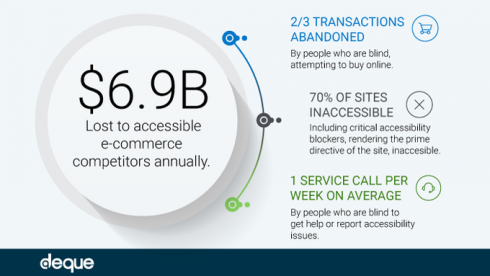
Despite efforts to make the web more accessible for people with disabilities, cognitive impairments and vision/hearing difficulties, there is still a digital divide. A new report from accessibility software company Deque Systems and conducted by Nucleus Research found that Internet websites in certain industries are largely inaccessible to people who have trouble with vision.
RELATED CONTENT:
Progress releases Web Accessibility Guidebook for developers
Getting started on the accessibility track
After interviewing 73 blind adults, the researchers found that around 70 percent of e-commerce, news and information and government categories had significant accessibility issues, prompting users to take their business to rival sites.
The research also found that Internet users who are blind abandon two Internet transactions a month because of inaccessibility, call a company’s customer service department once a week to navigate around the accessibilities, and that fewer than one in three websites had clear contact information or means for a consumer who is blind to report accessibility challenges or request.
According to Deque, this divide results in a $6.9 billion missed opportunity market. While many people with these disabilities use screen readers or screen magnifiers to navigate websites, many websites are not built with accessibility in mind and aren’t optimized to work with those, the company explained.
The report did find that well known companies such as Amazon, Best Buy and Target excelled in fixing accessibility issues in the ecommerce space.
“A focus on accessibility needs to be a core part of the website design and development process,” said Preety Kumar, the CEO of Deque Systems. “Considering accessibility as early as the conception phase, and proactively building and testing sites for accessibility as they move towards production, is significantly more effective than remediating it later, helping organizations save significant time and resources while avoiding unnecessary customer grievances.”
Other findings of the report included 7 out of 10 blind persons are unable to access information and services through government websites, 8 out of 10 news sites have accessibility issues.
“Besides the moral dilemma and legal risk, businesses with inaccessible websites are missing a huge revenue opportunity by ignoring an untapped market,” said Kumar. “Among internet retailers specifically, two-thirds of the top ten online retailers had serious accessibility issues, meaning they are leaving $6.9 billion in potential North American e-commerce revenues on the table.”
The full report can be viewed here.




